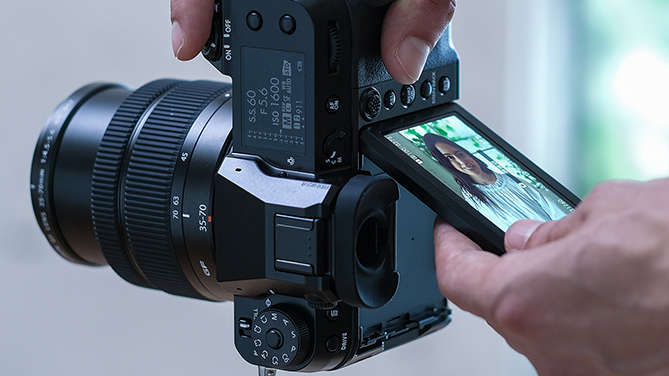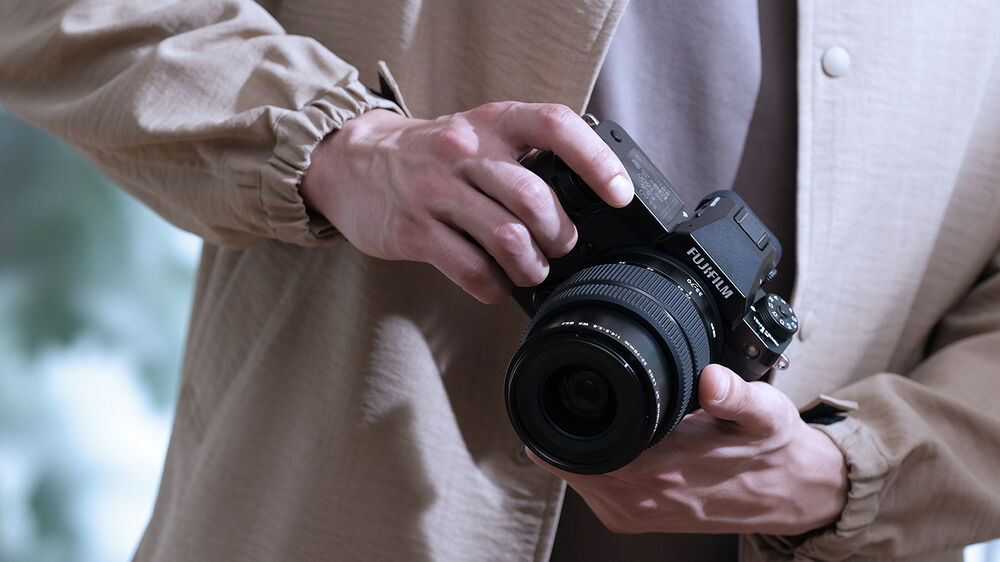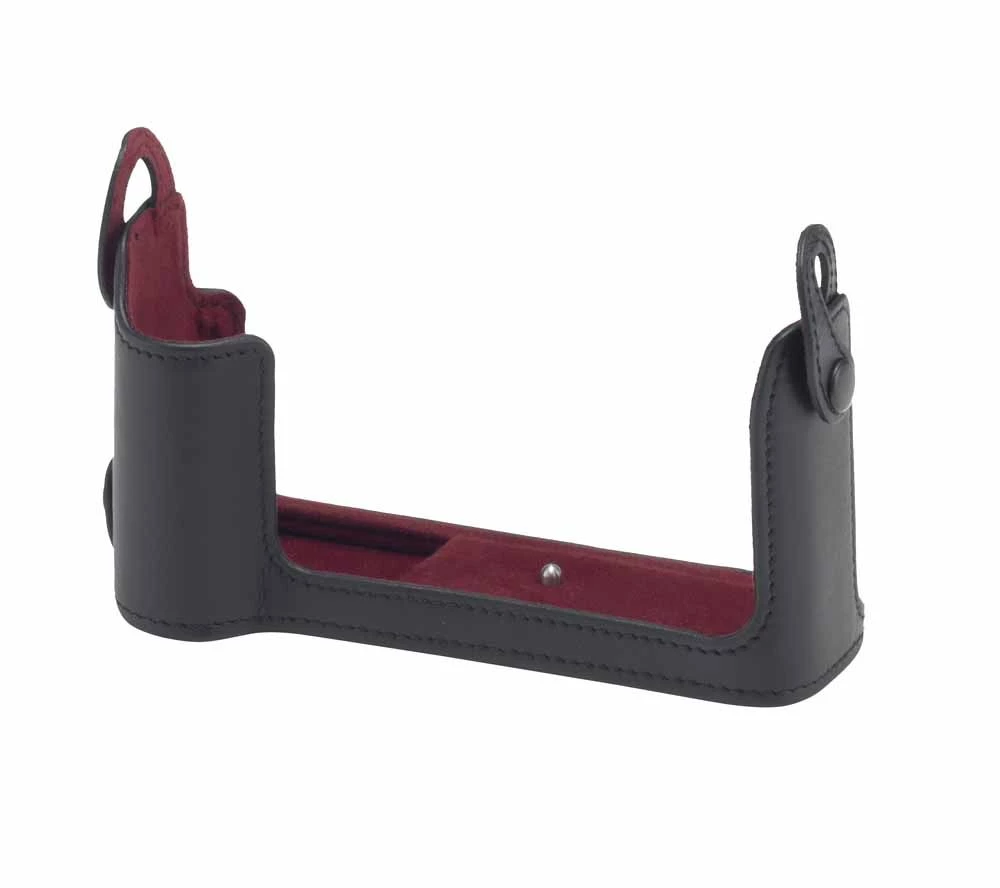FUJIFILM GFX 50S II Overview
Key Features
- 51.4MP 43.8 x 32.9mm CMOS Sensor
- X-Processor 4 Image Processor
- 3.69m-Dot OLED EVF
- 3.2" 2.36m-Dot Tilting Touchscreen LCD
- 117-Point Contrast-Detection AF System
- Extended ISO 50-102400, 3 fps Shooting
- Full HD 1080p Video Recording at 30 fps
- Multi Aspect Ratio Shooting
- Film Simulation Modes
- GF 35-70mm f/4.5-5.6 WR Lens
Offering the perfect mix of accessibility and flexibility, the GFX 50S II from FUJIFILM is a unique medium format mirrorless camera that is wonderfully compact and portable. Featuring a 51.4MP CMOS sensor paired with an improved X-Processor 4 image processor, this camera produces files with extremely wide dynamic range and high resolution, as well as having an extended sensitivity range of ISO 50-102400 for working in difficult lighting conditions. The sensor's large form factor also achieves a unique three-dimensional look with especially smooth tonal and color transitions.
The GFX 50S II has also been updated with a five-axis in-body image stabilization system that negates up to 6.5 stops of camera shake for improved handheld shooting, providing dramatically broad creative possibilities for image makers wanting to work more freely with slower shutter speeds. For composing images, a 3.69m-dot electronic viewfinder can be used for high-resolution eye-level viewing, and a rear 3.2" 2.36m-dot touchscreen LCD features a three-way tilting design that supports working from high and low angles. Additionally, the GFX 50S II offers a magnesium alloy build that is both lightweight and durable and is also dust- and weather-sealed, as well as freezeproof down to 14°F, for working in harsh environmental conditions.
51.4MP CMOS Sensor and X-Processor 4

Utilizing a large, 43.8 x 32.9mm 51.4MP CMOS sensor and an improved X-Processor 4, the GFX 50S II is capable of delivering high-resolution, 14-bit stills with a broad sensitivity range of ISO 100-12800, which can be extended to ISO 50-102400. The large size of each pixel allows for more efficient light gathering, too, for smoother tonal and color transitions to produce a characteristic three-dimensional "medium format look." Also contributing to several medium format looks, a variety of traditional medium and large format aspect ratios can be used in addition to the standard 4:3, including 1:1, 65:24, 5:4, 7:6, 3:2, and 16:9. The image processor and sensor also permit shooting continuously up to 3 fps or for recording Full HD 1080p video at 29.97, 25, 24, and 23.98 fps frame rates.

Sensor-Shift Image Stabilization
Standing out from its predecessor, the GFX 50S II features an in-body image stabilization system that provides up to an impressive 6.5 stops of five-axis stabilization. This provides dramatically broad possibilities for image makers wanting to work more freely with slow shutter speeds.

117-Point Autofocus System
Complimenting the updated image processor is a 117-point autofocus system enabling razor-sharp responses, whether subject tracking or picking out a face in a crowd. An improved autofocusing algorithm boosts focusing performance in all modes, including face and eye detection.

Additional Camera Features
- The FUJIFILM G lens mount features a short focal flange distance of just 26.7mm to better facilitate adapting lenses and to allow for reduced back focusing distances to better prevent vignetting and promote edge-to-edge sharpness with the GF series of lenses.
- Film Simulation modes allow you to reproduce the look and feel of 19 of FUJIFILM's film types, including Provia, Velvia, Astia, Eterna, Classic Chrome, Classic Neg., Pro Neg. Hi, Pro Neg. Standard, Acros, Monochrome, and Sepia. Additionally, Grain Effect can be adjusted as well as Classic Chrome effect to fine-tune the look of imagery.
- Mechanical focal plane permits working with shutter speeds from 60 min. up to 1/4000 sec, and an electronic shutter allows the use of shutter speeds up to 1/16000 sec for working in bright light conditions.
- Dual SD memory card slots are featured, and permit saving imagery in a sequential manner, backup/duplicate manner, or in a sorted manner to segregate JPEG and raw files.
- Tethered shooting is possible using X Acquire software to send images from the camera to a hot folder on your computer for further editing. Alternatively, the Tether Shooting Plug-in PRO for Adobe Photoshop Lightroom and HS-V5 for Windows operating systems are also available.

Body Design
- 3.69m-dot electronic viewfinder is included for high-resolution, 0.77x-magnification eye-level viewing.
- A 3.2" 2.36m-dot touchscreen LCD is also available for image playback, menu navigation, and live view shooting.
- LCD monitor is also featured on the top plate for settings confirmation and exposure data.

- Single NP-W235 rechargeable lithium-ion battery is rated to provide approximately 440 shots per charge.
- Built-in Wi-Fi allows for direct wireless sharing of files as well as remote camera control from a linked mobile device.
FUJIFILM GF 35-70mm f/4.5-5.6 WR Lens
Designed for the FUJIFILM G-mount GFX camera system, this GF 35-70mm f/4.5-5.6 WR Lens is a wide-angle zoom offering a 28-55mm equivalent focal length range. Covering wide-angle to normal-length perspectives, this zoom is well-suited to everyday shooting applications. Weighing less than a pound and offering a closed length of under 3", this compact and portable lens is engineered to produce images or video with incredible detail and minimal focus breathing, providing the perfect gateway to the capabilities and possibilities of the large format GFX System. Expansive landscapes, delicate portraits, and gritty documentaries are all within reach in the hands of the right storyteller. Additionally, the lens also features a dust-, freeze-, and weather-resistant design for use in inclement conditions.
Wide-angle to normal-length zoom offers a 28-55mm equivalent focal length to suit working in a variety of situations.
Minimum focusing distance of 13.8" to suit working with close-up subjects.
Dust- and weather-sealed physical construction enables working in harsh climates and temperatures as low as 14°F.
Weighs under 1 lb with a closed length of 2.9".
Fujifilm X-T20 Mirrorless Digital Camera with 15-45mm Lens (Black)
Key Features
- 24.3MP APS-C X-Trans CMOS III Sensor
- X-Processor Pro Image Processor
- 2.36m-Dot Electronic Viewfinder
- 3.0" 1.04m-Dot Tilting Touchscreen LCD
Fujifilm X-T20 Overview
Blending a familiar form factor with a heightened feature-set, the black X-T20 from Fujifilm is a sleek mirrorless camera designed for multimedia shooters. Utilizing a 24.3MP APS-C X-Trans CMOS III sensor and X-Processor Pro image processor, high-resolution stills can be recorded with notable sharpness and clarity due To the sensor organic layout and omission of an optical low-pass filter. The sensor and processor combination also avails an extended sensitivity Range To ISO 51200, a 14 fps continuous shooting rate when working with the electronic shutter, and the ability To record UHD 4K or Full HD 1080p video. When working with moving subjects, continuous autofocus performance has been optimized for improved moving subject tracking and overall accuracy, and Advanced SR Auto mode can also be used for fully automated shooting with intelligent scene recognition. Additionally, the retro-inspired camera body design incorporates a tilting 3.0" 1.04m-dot touchscreen LCD as well as a 2.36m-dot electronic viewfinder, and physical dials are available for quickly and intuitively adjusting exposure and shooting settings.
Included with the X-T20 is the XF 18-55mm f2.8-4 R LM OIS lens a standard zoom lens providing a 27-84mm equivalent focal length Range, covering wide-angle To portrait-length perspectives. This lens integrates optical image stabilization To minimize the appearance of camera shake To benefit working with longer shutter speeds or greater focal lengths and a linear motor-drive AF system provides fast, smooth focusing capabilities.
24.3MP APS-C X-Trans CMOS III Sensor
Utilizing Fujifilm unique, randomized pixel array, the 24.3MP APS-C X-Trans CMOS III sensor affords a high degree of image quality and sharpness due To the omission of an optical low-pass filter. Versus conventional pixel patterns, the X-Trans design more closely mimics the organic nature of film in order To produce nuanced colors and smooth tonal transitions, while also reducing moir© and aliasing.
X-Processor Pro
Aside from benefitting the low-light performance with an expandable sensitivity Range To ISO 51200, the X-Processor Pro also contributes To fast performance throughout the camera system, including a start-up time of 0.4 seconds, shutter lag time of 0.05 seconds, shooting interval time of 0.25 seconds, and a continuous shoot rate of 14 fps when working with an electronic shutter, or 8 fps with a mechanical shutter.
UHD 4K and Full HD Video
Accessible via the drive dial on the top plate, the X-T20 supports both recording in both UHD 4K/30p and Full HD 1080/60p resolutions. Film Simulation modes can be used during recording To give a distinct look To footage, and video can also be output via HDMI To an external recorder or monitor, and a mic jack is featured for working with an external microphone.
Body Design
- The rear 3.0" 1.04m-dot LCD touchscreen allows for intuitive operation, focus point Selection, and menu navigation, and its tilting design benefits working from high and low angles.
- High-resolution 2.36m-dot electronic viewfinder allows for bright, clear eye-level monitoring with a frame rate of 54.54 fps for smooth monitoring in a Range of lighting conditions.
- Dedicated shutter speed, drive mode, and exposure compensation dials for direct, intuitive control over exposure and shooting settings.
- The physical exposure compensation dial now features a C position To permit an expanded +/- 5 EV Range when working with the control dials.
- Built-in Wi-Fi allows for direct wireless sharing of files as well as remote camera control from a linked mobile device.
- Built-in pop-up flash is available for additional illumination, and a hot shoe is featured for working with an optional external flash.
91-Point Autofocus System
Utilizing both contrast- and phase-detection methods, the hybrid autofocus system employs 91 total points, which can be divided into 325 total areas for a high degree of focusing accuracy in a variety of lighting conditions. Approximately 50% side-to-side and 75% top-to-bottom of the frame is covered by phase-detection points in order To provide fast AF performance To suit working with moving subjects.
When working with autofocus, you can choose either single-shot AF-S mode or continuous AF-C mode, and each can be used in conjunction with Single Point AF, Zone AF, or Wide/Tracking AF settings. Additionally, AF-C Custom Settings let you choose from five AF-C presets depending on how your subject is moving, and the AF algorithm has been optimized for improved subject tracking and overall accuracy.
Film Simulation Modes
Taking advantage of Fujifilm vast history in traditional film-based photography, the X-T20 integrates several Film Simulation modes, which can be used for photos or videos, To mimic the look and feel of some of Fujifilm classic film types. A refined Classic Chrome mode is designed To deliver muted tones and a deep color reproduction, similar To that of a dated slide film. Pulling from their more contemporary line of transparency films, Provia offers natural-looking tones for everyday shooting, Velvia produces a more dramatic and rich tonality with deeper color saturation, and Astia gives less contrast for a softer depiction of skin tones. Mimicking their negative films, Pro Neg. Std. gives smooth image tones that are suitable for accurate color renditions, while Pro Neg. Hi produces a more dramatic feel with the ability To draw color out of a variety of lighting conditions. In addition To the colorful benefits of these Film Simulation modes, there are also monochrome modes that simulate the look of traditional yellow, green, and red black and white contrast filters, as well as an Acros mode that can also be paired with colored filter effects. A sepia mode is also available for producing an inherently nostalgic look.
Fujifilm XC 15-45mm f3.5-5.6 OIS PZ Lens
The XC 15-45mm is composed of ten elements in nine groups, three of which are aspherical and two that are extra-low dispersion (ED) To help achieve optimal image quality and sharpness. It features notable close-up capabilities, focusing as close as 5.1" in wide focal lengths. Fully featured, the lens offers optical image stabilization with claims of up To 3 stops of compensation, as well as autofocus via an inner motor for quick and quiet operation. The maximum aperture varies by little more than a stop, from f3.5 To f5.6 depending on your focal length, and the minimum aperture is f22 when fully stopped down.
Fujinon XC 50-230mm f4.5-6.7 OIS
The silver Fujifilm XC 50-230mm f4.5-6.7 OIS Lens is an expansive telephoto zoom lens that provides a 35mm-equivalent focal length Range of 76-350mm, covering portrait-length To telephoto perspectives. This broad Range of coverage is well-suited To working with distant subjects and the integration of optical image stabilization To help minimize the appearance of camera shake works To produce sharper imagery when working in low-light conditions throughout the zoom Range. Benefitting working with moving subjects and for video applications, a precision stepping AF motor is incorporated into the lens To provide high-speed, accurate focusing capabilities.
Other Camera Features
- Advanced SR Auto mode can be used for fully automatic shooting with scene recognition To permit on-the-fly shooting in a variety of settings.
- Interval Timer shooting lets you record an infinite number of consecutive frames with 1 second To 24 hour intervals, and a 1 minute To 24 hour starting delay.
- Multiple Exposure mode lets you shoot two consecutive overlaid frames, and the first frame will be shown on the rear LCD To aid in alignment for the second exposure.
- In-camera 180° panoramas can be shot by simply panning the camera about the scene.
- Advanced Filters: Toy Camera, Dynamic Tone, Miniature, High Key, Soft Focus, Pop Color, Low Key, and Partial Color (Red, Orange, Yellow, Green, Blue, and Purple).
Fujifilm X-T20 Mirrorless Digital Camera with 15-45mm Lens (Black)
Key Features
- 24.3MP APS-C X-Trans CMOS III Sensor
- X-Processor Pro Image Processor
- 2.36m-Dot Electronic Viewfinder
- 3.0" 1.04m-Dot Tilting Touchscreen LCD
Fujifilm X-T20 Overview
Blending a familiar form factor with a heightened feature-set, the black X-T20 from Fujifilm is a sleek mirrorless camera designed for multimedia shooters. Utilizing a 24.3MP APS-C X-Trans CMOS III sensor and X-Processor Pro image processor, high-resolution stills can be recorded with notable sharpness and clarity due To the sensor organic layout and omission of an optical low-pass filter. The sensor and processor combination also avails an extended sensitivity Range To ISO 51200, a 14 fps continuous shooting rate when working with the electronic shutter, and the ability To record UHD 4K or Full HD 1080p video. When working with moving subjects, continuous autofocus performance has been optimized for improved moving subject tracking and overall accuracy, and Advanced SR Auto mode can also be used for fully automated shooting with intelligent scene recognition. Additionally, the retro-inspired camera body design incorporates a tilting 3.0" 1.04m-dot touchscreen LCD as well as a 2.36m-dot electronic viewfinder, and physical dials are available for quickly and intuitively adjusting exposure and shooting settings.
Included with the X-T20 is the XF 18-55mm f2.8-4 R LM OIS lens a standard zoom lens providing a 27-84mm equivalent focal length Range, covering wide-angle To portrait-length perspectives. This lens integrates optical image stabilization To minimize the appearance of camera shake To benefit working with longer shutter speeds or greater focal lengths and a linear motor-drive AF system provides fast, smooth focusing capabilities.
24.3MP APS-C X-Trans CMOS III Sensor
Utilizing Fujifilm unique, randomized pixel array, the 24.3MP APS-C X-Trans CMOS III sensor affords a high degree of image quality and sharpness due To the omission of an optical low-pass filter. Versus conventional pixel patterns, the X-Trans design more closely mimics the organic nature of film in order To produce nuanced colors and smooth tonal transitions, while also reducing moir© and aliasing.
X-Processor Pro
Aside from benefitting the low-light performance with an expandable sensitivity Range To ISO 51200, the X-Processor Pro also contributes To fast performance throughout the camera system, including a start-up time of 0.4 seconds, shutter lag time of 0.05 seconds, shooting interval time of 0.25 seconds, and a continuous shoot rate of 14 fps when working with an electronic shutter, or 8 fps with a mechanical shutter.
UHD 4K and Full HD Video
Accessible via the drive dial on the top plate, the X-T20 supports both recording in both UHD 4K/30p and Full HD 1080/60p resolutions. Film Simulation modes can be used during recording To give a distinct look To footage, and video can also be output via HDMI To an external recorder or monitor, and a mic jack is featured for working with an external microphone.
Body Design
- The rear 3.0" 1.04m-dot LCD touchscreen allows for intuitive operation, focus point Selection, and menu navigation, and its tilting design benefits working from high and low angles.
- High-resolution 2.36m-dot electronic viewfinder allows for bright, clear eye-level monitoring with a frame rate of 54.54 fps for smooth monitoring in a Range of lighting conditions.
- Dedicated shutter speed, drive mode, and exposure compensation dials for direct, intuitive control over exposure and shooting settings.
- The physical exposure compensation dial now features a C position To permit an expanded +/- 5 EV Range when working with the control dials.
- Built-in Wi-Fi allows for direct wireless sharing of files as well as remote camera control from a linked mobile device.
- Built-in pop-up flash is available for additional illumination, and a hot shoe is featured for working with an optional external flash.
91-Point Autofocus System
Utilizing both contrast- and phase-detection methods, the hybrid autofocus system employs 91 total points, which can be divided into 325 total areas for a high degree of focusing accuracy in a variety of lighting conditions. Approximately 50% side-to-side and 75% top-to-bottom of the frame is covered by phase-detection points in order To provide fast AF performance To suit working with moving subjects.
When working with autofocus, you can choose either single-shot AF-S mode or continuous AF-C mode, and each can be used in conjunction with Single Point AF, Zone AF, or Wide/Tracking AF settings. Additionally, AF-C Custom Settings let you choose from five AF-C presets depending on how your subject is moving, and the AF algorithm has been optimized for improved subject tracking and overall accuracy.
Film Simulation Modes
Taking advantage of Fujifilm vast history in traditional film-based photography, the X-T20 integrates several Film Simulation modes, which can be used for photos or videos, To mimic the look and feel of some of Fujifilm classic film types. A refined Classic Chrome mode is designed To deliver muted tones and a deep color reproduction, similar To that of a dated slide film. Pulling from their more contemporary line of transparency films, Provia offers natural-looking tones for everyday shooting, Velvia produces a more dramatic and rich tonality with deeper color saturation, and Astia gives less contrast for a softer depiction of skin tones. Mimicking their negative films, Pro Neg. Std. gives smooth image tones that are suitable for accurate color renditions, while Pro Neg. Hi produces a more dramatic feel with the ability To draw color out of a variety of lighting conditions. In addition To the colorful benefits of these Film Simulation modes, there are also monochrome modes that simulate the look of traditional yellow, green, and red black and white contrast filters, as well as an Acros mode that can also be paired with colored filter effects. A sepia mode is also available for producing an inherently nostalgic look.
Fujifilm XC 15-45mm f3.5-5.6 OIS PZ Lens
The XC 15-45mm is composed of ten elements in nine groups, three of which are aspherical and two that are extra-low dispersion (ED) To help achieve optimal image quality and sharpness. It features notable close-up capabilities, focusing as close as 5.1" in wide focal lengths. Fully featured, the lens offers optical image stabilization with claims of up To 3 stops of compensation, as well as autofocus via an inner motor for quick and quiet operation. The maximum aperture varies by little more than a stop, from f3.5 To f5.6 depending on your focal length, and the minimum aperture is f22 when fully stopped down.
Fujinon XC 50-230mm f4.5-6.7 OIS
The silver Fujifilm XC 50-230mm f4.5-6.7 OIS Lens is an expansive telephoto zoom lens that provides a 35mm-equivalent focal length Range of 76-350mm, covering portrait-length To telephoto perspectives. This broad Range of coverage is well-suited To working with distant subjects and the integration of optical image stabilization To help minimize the appearance of camera shake works To produce sharper imagery when working in low-light conditions throughout the zoom Range. Benefitting working with moving subjects and for video applications, a precision stepping AF motor is incorporated into the lens To provide high-speed, accurate focusing capabilities.
Other Camera Features
- Advanced SR Auto mode can be used for fully automatic shooting with scene recognition To permit on-the-fly shooting in a variety of settings.
- Interval Timer shooting lets you record an infinite number of consecutive frames with 1 second To 24 hour intervals, and a 1 minute To 24 hour starting delay.
- Multiple Exposure mode lets you shoot two consecutive overlaid frames, and the first frame will be shown on the rear LCD To aid in alignment for the second exposure.
- In-camera 180° panoramas can be shot by simply panning the camera about the scene.
- Advanced Filters: Toy Camera, Dynamic Tone, Miniature, High Key, Soft Focus, Pop Color, Low Key, and Partial Color (Red, Orange, Yellow, Green, Blue, and Purple).

 (7).webp)

.webp)
.webp)
